Botulinum Toxins or Clostridium Botulinum Neurotoxins
Botulinum neurotoxins (BoNTs), occur in several serotypes or toxin types designated BoNT/A, BoNT/B, and continuing alphabetically to cover all different types discovered. These neurotoxins are produced as large protein complexes comprised of the neurotoxin with a non-toxic non-hemagglutinin (NTNH) and some additional hemagglutinins (HA). Neurotoxin is a 150 kDa protein which when activated by nicking (proteolytic cleavage) forms an approximately 50 kDa light chain (LC) domain responsible for enzyme activity and a 100 kDa heavy chain (HC) domain responsible for both binding to cellular targets and translocation.
All botulinum toxins have a similar effect, muscle paralysis, caused by disabling the mechanism used to send messages from neurons to muscles, the vesicle fusion machinery. Botulinum toxin light chains are zinc-dependent proteases, which target specific proteins involved in vesicle fusion, cleaving different SNARE proteins at specific locations. When this happens, the vesicles containing neurotransmitters are not able to attach and deliver their contents at the synapses, resulting in paralysis. BoNT types A, C, and E cleave synaptosomal-associated protein (SNAP-25) at different sites. In addition, BoNT type C cleaves syntaxin. Another protein, called VAMP or synaptobrevin, is the target for BoNT toxin types B, D, F, and G; each toxin cleaving at a different location in the protein. The net result of neurotoxin activity is the same, neurotransmitter containing vesicles are disabled with all serotypes, causing muscle paralysis.
Botulinum toxins start on the path to paralysis by first binding to specific receptors which are distributed among different cell types. This is an area currently under investigation, but it seems that BoNT/A binds to both a membrane protein known as synaptic vessel protein 2 (SV2) and a ganglioside which is abundant on neurons. This two-component binding is common among the serotypes, a ganglioside and specific protein or second ganglioside function together in binding the neurotoxin. The selective nature of binding two specific receptors, compounded with specificity of the target, make botulinum neurotoxins precise tools in disabling control of muscles by nerves.
List Labs provides several neurotoxins as research tools. Additionally, we have reagents which may be used to develop detection of the neurotoxins such as antibodies and peptide substrates. Recombinant toxin chains are also available and offer the advantage that they are non-toxic.
Toxin Complex, nicked
Clostridium botulinum neurotoxins (BoNT) are among the most toxic substances known to man. These substances are possessed and handled following strict regulations. List Labs produces Clostridium botulinum neurotoxin type A (BoNT/A), type B (BoNT/B) and type E (BoNT/E) in native culture and produces type D (BoNT/D) recombinantly. Native botulinum neurotoxins are formed complexed with one or more nontoxic neurotoxin-associated proteins (NAPs) and hemagglutinin (HA). Specific aggregations of neurotoxin and accessory proteins are called toxin complexes. When toxin complex is in a pH neutral or slightly basic environment the complex dissociates releasing the neurotoxin. In the list of products below find toxin complex from three different serotypes: Type A Complex, Type B Complex and Type E Complex. For your convenience, all of these toxins are activated by proprietary nicking processes allowing proteolytic cleavage of the complexed neurotoxin. This nicked toxin is ready to bind, translocate and attack its substrate, ready for you to use without added enzymes or loss of protein.
- Product #128 Botulinum Neurotoxin Type A Complex (Nicked)
- Product #138 Botulinum Neurotoxin Type B Complex, Nicked
- Product #140 Botulinum Neurotoxin Type E Complex, Nicked
Neurotoxins
Neurotoxin may be purified from toxin complex, free of the complexing proteins. The resulting protein, approximately 150 kDa in size is often called neurotoxin, pure neurotoxin or isolated toxin to distinguish it from the toxin complex. Types A, B and E neurotoxin are purified at List Labs from the toxin complexes. In comparison, type D neurotoxin is produced recombinantly as a single protein. All neurotoxins we provide are activated. Certificates of analysis describing purity and endotoxin analysis results accompany each shipment.
- Product #130 Botulinum Neurotoxin Type A Nicked
- Product #136 Botulinum Neurotoxin Type B, Nicked
- Product #141 Botulinum Neurotoxin Type E, Nicked
- Product #146 Botulinum Neurotoxin Type D, Nicked, Recombinant
Toxoids
Purified neurotoxin is treated with formaldehyde to inactivate the toxin while maintaining epitopes which may be recognized by antibodies. The current lot of BoNT/A toxoid has been prepared using an optimized method for formaldehyde toxoiding. It has been tested for antigenicity and compared with the antigen reactivity of pure neurotoxin. It has been shown that the toxoid resembles the native toxin but is not toxic. Two botulinum toxin toxoids are available from List Labs.
- Product #133L Botulinum Neurotoxin Type A Toxoid, Liquid
- Product #139 Botulinum Neurotoxin Type B Toxoid
Recombinant Light and Heavy Chains
Botulinum neurotoxins are large molecules which may be divided into three functional domains. When neurotoxin is nicked and reduced it separates into two parts, a light chain and a heavy chain of approximately 50 KDa and 100 kDa, respectively. It is possible to make these chains recombinantly guaranteeing that a preparation of light chain, for example, is completely free of heavy chain. Importantly, chains made recombinantly are not toxic. The light chain alone cannot enter and alter cells. Research which can be done with the light chain alone is free of the restrictions imposed on use of the whole toxin. Light chains have been useful in the search for toxin inhibitors and in the study of the enzyme activity. List provides the following light chains.
- Product #610 Type A Light Chain
- Product #611 Type A Light Chain, GST fusion
- Product #620 Type B Light Chain
- Product #625Type C Light Chain
- Product #630 Type D Light Chain
- Product #635 Type E Light Chain
- Product #640 Type F Light Chain
As described above, when nicked neurotoxin is reduced it separates into two parts, one of which is a heavy chain of approximately 100 kDa. This heavy chain has two functional domains, one responsible for binding to the cellular receptor and the other domain responsible for translocation. The binding domains of neurotoxin heavy chains, approximately 50 kDa in size, have been expressed in E.coli and purified. Heavy chain binding domains for both type A and type B are offered, either free or fused to GST.
- Product #612 Type A Heavy Chain Binding Domain
- Product #613 Type A Heavy Chain Binding Domain, GST fusion
- Product #622Type B Heavy Chain Binding Domain
- Product #623Type B Heavy Chain Binding Domain, GST fusion
Native Substrates
Botulinum neurotoxins act on the cellular machinery which allows vesicles full of neurotransmitters to attach or dock to membranes at the neuromuscular junctions. SNARE proteins are the functioning part of this cellular machinery and the location of attack by neurotoxins. SNAREs form transient bundles, binding the vesicles to presynaptic membranes. Syntaxin and SNAP-25 reside in cell membranes and synaptobrevin is located in vessicle membranes. Toxin light chains are proteases which cleave SNARE proteins at specific locations and when cleaved the SNARES are inactive.
List Labs provides two recombinant proteins representing the cleavage sites of SNARE proteins, SNAP-25 and Synaptobrevin-2. These native substrates can be used to assess the enzyme activity of botulinum toxins. Cleavage may be monitored through analysis of generated cleaved product on SDS-PAGE gel electrophoresis.
SNAP-25 can be used as a substrate for either type A or type E botulinum toxin. Synaptobrevin-2 is provided with a GST tag and acts as a substrate for types B, D and F. In addition, Synaptobrevin is a substrate for the closely related tetanus toxin. Each combination of toxin and substrate requires specific conditions for cleavage. This information is included in the C of A.
- Product #500 SNAP-25 Recombinant Protein Substrate for C. botulinum Types A and E Neurotoxin
- Product #510 GST Synaptobrevin-2 Recombinant Protein Substrate for C. botulinum Types B, D, F and tetanus toxin
FRET Peptide Substrates
Starting with the sequence of amino acids in the native substrates, List Labs has designed peptides incorporating amino acids around the botulinum toxin cleavage sites allowing for specific recognition by the toxin light chains. Each Substrate Peptide incorporates a flurophore and a chromatogenic acceptor on the opposite side of the point of cleavage. Fluorescence is quenched initially by intramolecular energy transfer between the donor/acceptor pair in these FRET peptides. When the peptides are cleaved at the botulinum toxin site, the flurophores are released and full fluorescence may be observed. The increase in fluorescence intensity is directly proportional to the amount of toxin enzyme present. Calibration Peptides which are the cleaved substrate containing fluorophore are used to generate curves used to convert fluorescence to nmoles of cleaved substrate. A Control peptide is available for use with Botulinum neurotoxin type A SNAPtide® that is not cleaved by the neurotoxin but contains all remaining non-specific sites in the sequence. This control can be used to screen background cleavage of the substrate that can occur in complex matrices.
FRET peptide substrates for C. botulinum Type A neurotoxin
For Botulinum neurotoxin type A, List Labs offers SNAPtide® peptide substrates, incorporation the type A cleavage site, with three different FRET pairs, two of the substrates have companion calibration and control peptides.
- Product #520 SNAPtide® (oAbz/Dnp) Peptide Substrate
- Product #529 Unquenched Calibration Peptide for SNAPtide® 520
- Product #525 Control Peptide for SNAPtide® 520
- Product #521SNAPtide® (FITC/DABCYL) Peptide Substrate
- Product #528 Unquenched Calibration Peptide for SNAPtide® 521
- Product #526 Control Peptide for SNAPtide® 521
- Product #523 SNAPtide® flP6 (DABCYL/5-IAF) Peptide Substrate
FRET peptide substrate for C. botulinum Type B neurotoxin
For Botulinum neurotoxin type B, List Labs offers VAMPtide ® peptide substrates with three different FRET pairs, one peptide has a companion calibration peptide. VAMPtide ® incorporates the cleavage site for tetanus toxin and the toxin must be used at comparably higher concentrations.
- Product #540 VAMPtide ® (oAbz/Dnp) Peptide Substrate
- Product #549 Calibration Fluorophore for VAMPtide ®540
- Product #541 VAMPtide ® (FITC/DABCYL) Peptide Substrate
- Product #542 VAMPtide ® (PL 150, Pya/Nop) Peptide Substrate
FRET peptide substrate for C. botulinum Type E neurotoxin
For Botulinum neurotoxin type E, List Labs offers a SNAP Etide® peptide substrate with a companion calibration peptide.
- Product #550 SNAP Etide® (oAbz/Dnp) Peptide Substrate
- Product #559 Unquenched Calibration Peptide for SNAP Etide® 550
FRET peptide substrate for C. botulinum Type C neurotoxin
For Botulinum neurotoxin type C, List Labs offers a SYNTAXtide® peptide substrate.
- Product #560 SYNTAXtide® (oAbz/Dnp) Peptide Substrate
Receptor
The synaptic vesicle glycoprotein 2c (SV2c) has been shown to be the protein receptor for Botulinum neurotoxin, Type A. Specifically BoNT/A binds to the luminal domain loop. List Labs provides a 124 amino acid GST fusion protein, the luminal domain of SV2c, for binding the toxin. This protein is covered by U.S. Patent #8,476,024.
- Product #690 GST-SV2c, Receptor for Botulinum Neurotoxin Type A Luminal domain loop of SV2c
Antibodies
Antibodies for C. botulinum Type A neurotoxin
Antibodies against two functional domains of type A toxin are available for use in capturing and identifying and the toxin. The mouse monoclonal is highly specific toward the toxin light chain and is non-neutralizing.
- Product #730 Anti-Botulinum Neurotoxin Type A (Chicken lgY) Raised against Product #612, the heavy chain binding domain of botulinum Type A neurotoxin
- Product #730 Anti-Botulinum Neurotoxin Type A (Chicken lgY) Raised against Product #612, the heavy chain binding domain of botulinum Type A neurotoxin
- Product #731L Anti-Botulinum Neurotoxin Type A (mouse IgG monoclonal F1-40) Monoclonal antibody binds the light chain of botulinum neurotoxin Type A
Antibodies for C. botulinum Type B neurotoxin
Showing 1–12 of 17 results
-
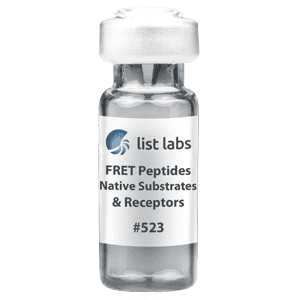
SNAPtide® Peptide Substrate flP6(DABCYL/5-IAF) for C. botulinum Type A Neurotoxin
#523 (200 nmoles)
-

VAMPtide® (Pya/Nop) Peptide Substrate for Botulinum Neurotoxin Type B
#542 (200 nmoles)
-
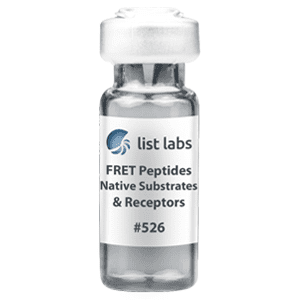
Control Peptide for SNAPtide® 521 for C. botulinum Type A Neurotoxin
#526 (200 nmoles)
-
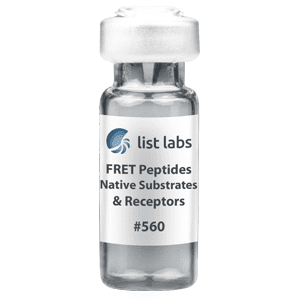
SYNTAXtide® (o-Abz/Dnp) Peptide Substrate for C. botulinum Type C Neurotoxin
#560 (200 nmoles)
-
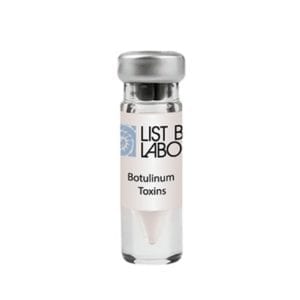
Unquenched Calibration Peptide for SNAP Etide® Prod #550
#559 (50 nmoles)
-
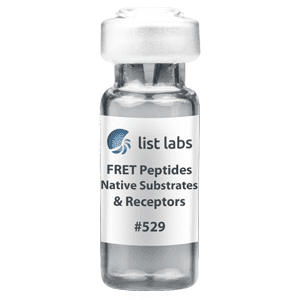
Unquenched Calibration Peptide for SNAPtide® 520 Substrate for C. botulinum Type A Neurotoxin
#529 (50 nmoles)
-
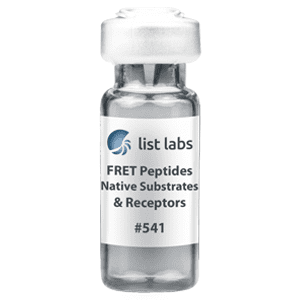
VAMPtide® Peptide Substrate (FITC/DABCYL) Substrate for C. botulinum Type B Neurotoxin
#541 (200 nmoles)
-
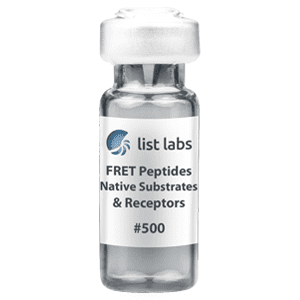
SNAP-25 Recombinant Protein Substrate for C. botulinum Types A and E Neurotoxin
#500A (100 ug)
-
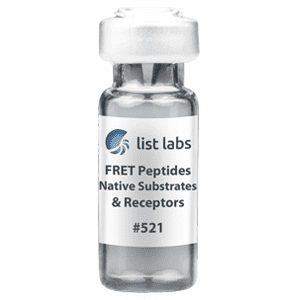
SNAPtide® Peptide Substrate (FITC/DABCYL) for C. botulinum Type A Neurotoxin
#521 (200 nmoles)
-
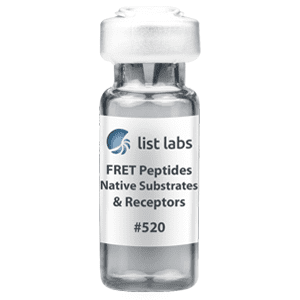
SNAPtide® Peptide Substrate (o-Abz/Dnp) for C. botulinum Type A Neurotoxin
#520 (200 nmoles)
-
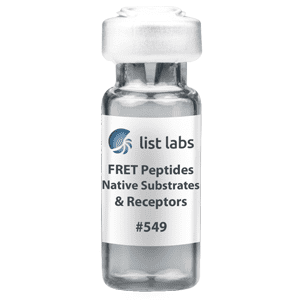
Calibration Fluorophore for VAMPtide® 540 Substrate for C. botulinum Type B Neurotoxin
#549 (100 nmoles)
-
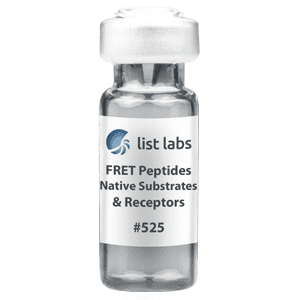
Control Peptide for SNAPtide® 520 Substrate for C. botulinum Type A Neurotoxin
#525 (200 nmoles)


